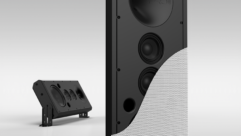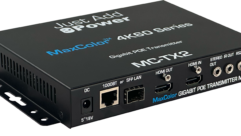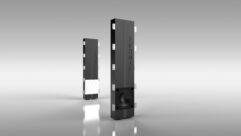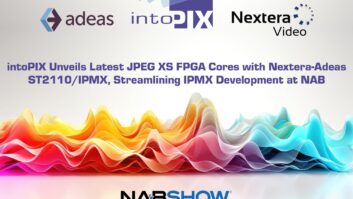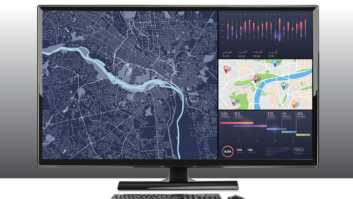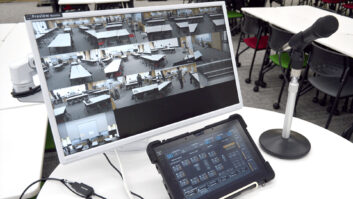CEDIA EXPO ’99: deja vu all over again
Nov 1, 1999 12:00 PM,
Pete Putman
The theme of CEDIA EXPO ’99 should have been: “Recycling is in.” Afterspending several days at this year’s show in Indianapolis, two trends havebecome quite clear. Manufacturers of CRT front projectors are concentratingon the consumer home theater market as demand in the professional A-Vchannel shifts to flat-matrix projection systems. Also, manufacturers ofLCD and DLP projectors are rolling out consumer class B versions almost asquickly as their class A industrial/corporate counterparts.
There were quite a few CRT projectors, a dizzying number to choose fromthis year. Seleco had three new designs with 7 inch (178 mm) tubes, whileRunco showed four models. One of them, the DTV-992, is essentially aBarcoGraphics 808 with autoconvergence circuitry. Zenith also rolled out anew CRT front projector, the Pro 1200, another recycled Barco design.
Vidikron had a few offerings in its unique styling, and Sony continues tosell its VPH-G70 and VPH-G90 8 inch (203 mm) and 9 inch (229 mm) modelsalongside the 7inch D50/D50HTU. Perhaps the biggest surprise was Madrigal’snew MP-8 and MP-9 8 inch and 9 inch front projectors. These are alsorecycling projects; you have seen them before as the Electrohome Marquee8500 and 9500, but these two projectors are not cheap at $45,000 and$60,000, respectively.
On to flat-matrix imaging. Two years ago, you could count the number ofcompanies selling LCD- or DLP-engined front projectors on the fingers ofone hand. Now, it seems that everyone is getting into the game. In fact,some manufacturers are actually competing with their OEM partners.
DreamVision, Plattsburgh, NY, has done fairly well with the DL500projector, an adaptation of a chassis first manufactured two years ago byDavis of Norway. Originally known as the DL450, this small, 9.9 pound (4.5kg) box uses a single 848 600 digital micromirror device (DMD) andincorporates power zoom and power focus.
Since then, Davis has undergone a major corporate restructuring while theDL450 slipped off everyone’s radar in the professional A-V channel, butDreamVision’s success with this product has inspired Davis to dip its owntoes into the home theater market, and the two companies exhibitedessentially the same product just a few aisles apart. Davis’ offering willbe called the Cinema One. (DreamVision also has decided to recycle the ASKA6 SVGA LCD desktop projector from the professional A-V channel, calling itthe White Magic.)
No to be outdone, Runco also showed its version of the DL450 (the Lumiere)in private press meetings and dealer previews. No attendees could be blamedif they thought they were seeing double, or in this case, triple. The pricedifference among the three models is minimal – about a thousand dollars,although there were noticeable differences in image quality. Runco is alsoon the verge of recycling long-time partner NEC Technologies’ GT2000high-resolution installation LCD projector, which uses three 1,280 1,024panels. (No decision yet on what to do with this box.)
Fujitsu, a powerhouse OEM that resells plasma to numerous companies,including Sony, and even makes projectors for Electrohome and Telex,decided to feature its products in its own booth, including a 1,000 lumenXGA LCD projector previously intended for boardroom use. This had to be anawkward moment for Telex, whose booth was directly across the aisle fromFujitsu.
If two different versions of the same product are launched simultaneously,does that constitute recycling? Sharp Electronics (professional A-V)recently announced the Notevision 6, a 2,000 lumen desktop XGA (1,024 7,68)projector intended for the professional A-V market, but the first NV6shipments had hardly left the loading dock when SharpVision (consumer)rolled out the XV-DW100U, a 1,000 lumen version of the same projectorshipping early next year.
PLUS Corporation could not resist the urge to visit Indianapolis either,showing the exact same U2-870 SVGA and U2-1080 XGA ultraportable DLPprojectors that are offered to the professional crowd. Ditto Toshiba, whichhad a major rollout at INFOCOMM with six new models. One of them, theTLP450, has already found its way into the home theater market. Now brandedas the TLP-MT1, it has a three-panel 800 600 polysilicon LCD light engineand is capable of showing both 4:3 and 16:9 letterbox video. A separate RGBinput works with computer displays and 480p outputs from Toshiba’s newprogressive-scan DVD players.
JVC, fresh from its consolidation with Hughes-JVC in California, broughtalong a full rack of presentation displays from INFOCOMM, showcasing theD-ILA technology in the G10 (1,000 lumens) and G15 (1,500 lumens). Bothprojectors use a xenon lamp and 1,365 1,024 reflective LCD panels. There iseven a rear-projection version of this projector, which was originallyintended for the boardroom/conference room market.
Things are just as crazy with the large-screen monitor folks, particularlyamong the plasma manufacturers. Sony showed both wide VGA and wide XGA 42inch (1,067 mm) plasma panels, as did Fujitsu. Panasonic rolled out the PT-42PD1 42 inch wide VGA plasma for the consumer market, and reseller Electrograph had Toshiba’s PD42W1 42 inch panel available. NEC’s new 42 inch offeringswere available through Runco and JVC, and Pioneer released the consumerversion of its 50 inch (1,270 mm) plasma display at the show.
There were a few new products at the show that will get recycled in theother direction from consumer to professional. Sharp’s LC-R60HDU 60 inch(1.5 m) RP TV is notable for its unique imaging technology – three 2.6 inch(66 mm) Continuous Grain Silicon (CGS) LCD panels with 1,280 1,024non-square pixels. These are currently the highest-resolution flat-matriximaging devices available in a true 16:9 aspect ratio (JVC’s D-ILA measures1,365 1024 in a 4:3 package), and you can bet that they will wind up in aninstallation LCD projector by INFOCOMM 2000.
Sony also showed the successor to its popular VPL-W400Q video projector,unveiling the VPL-VW10HT LCD projector. It uses three new 1,365 768polysilicon LCD panels and is rated at 1,000 lumens (700 lumens cinemablack mode). This product will surely find favor among professional A-Vdealers as a reasonably priced HDTV projection solution, probably in itscurrent incarnation with little or no changes. It is, after all, RGB-readybut uses five color-coded RCA jacks for component inputs.
In an unusual move, SharpVision has taken the original Notevision 1(professional) chassis and re-engineered it for home theater. When firstsold through the professional A-V market, the Notevision 1 used 800 600polysilicon LCD panels for imaging. The new, improved home theater versionuses 640 480 polysilicon panels and produces 350 ANSI lumens. Where didthose panels come from? No doubt they were recycled from OEM partner Sony,whose last VGA-engined projector (VPL-V500Q) has been out of the Sonyproduct line for some time.
Among the interface crowd, Extron Electronics did a little cosmeticreworking to introduce a new line of switchers and distribution amps. TheSW6 component/HDTV switcher and ADA 6 component/HDTV distribution amp aremerely adaptations of other RGBHV designs, re-lettered and configured withthree BNC jacks per video channel. Extron is also offering productspreviously reserved for the professional market, such as the VCS 300 and300D scan converters, EQ100 video EQ and DVS100 video scalar.
RGB Spectrum also sees opportunity in the consumer market, with a brand-newline multiplier (DTQ doubler/tripler/quadrupler), higher-end video scalar(VLI200), and a computer/video scan rate mixer, the SynchroMaster 350. Thislast product essentially performs the functions of Snell and Wilcox’sInterpolator, but at a much lower price.
Faroudja has been straddling the line between professional and consumer formany years and, in fact, showed a pair of video (DVP-3000 series) scalarsthat premiered at INFOCOMM. On the other hand, Communications Specialties,a company that concentrated solely on the professional until now, showedoff the new Deuce Pro video scalar and a couple of scan converters.
What significance can be drawn from these product showings? For one thing,the boundaries between professional A-V and consumer monitors, projectorsand interfaces is becoming less distinct each year. I cannot remember atime when so many products had dual debuts into both markets, particularlyall of the current-generation plasma display panels.
>From a systems integrator standpoint, most of the boundaries between>professional A-V and consumer are gone; even Pioneer’s PDP-505HD consumer>50 inch plasma is essentially the PDP-V502MX professional version with a>few bells and whistles changed. Philips Electronics has long been in the>vanguard of offering professional products that are re-branded as consumer>products, but there will soon be others.
Finally, there are the winds of change. Two scant years ago, the majorityof displays shown at CEDIA used picture tubes or projection CRTs. Now, youcan see a tidal wave of flat-matrix technologies approaching, just as itoverwhelmed INFOCOMM this past June. Thinkabout this: At the 1997 INFO-COMMProjection Shoot-Out, there were a total of 19 CRT front projectorsentered. This year, there were exactly three models in the competition; allother front projectors used LCD or DLP.
To me, there is absolutely no question that the home theater market willsoon be overrun with LCD and DLP projectors, just like INFOCOMM. Theircombination of low price and plug-and-play operation will appeal to manybuyers. How can you go wrong with a 14 pound, (6.3 kg) 350 lumen 640 480LCD video projector for under $4,000 that is also 480p-ready?



